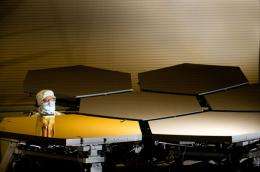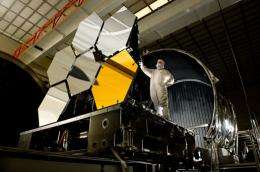First James Webb Space Telescope primary mirror segment to achieve final step

A bit of gold made its way into the Rocket City last week in the form of a gold-coated James Webb Space Telescope primary mirror segment. It is the first primary mirror segment to achieve the final step in the manufacturing process, prior to undergoing cryogenic testing in the X-ray & Cryogenic Facility at NASA's Marshall Space Flight Center in Huntsville, Ala.
The mirror segment, an engineering development unit and flight spare, has been coated with an ultra-thin layer of gold to ensure that infrared light is properly reflected from the primary mirror into the observatory's science instruments. The primary mirror engineering development unit will be closely followed by the other 18 primary mirror flight segments in the coating process.
During cryogenic testing, the mirrors are subjected to extreme temperatures dipping to -415 degrees Fahrenheit, which permits NASA contractor engineers to measure in extreme detail how the shape of the mirror changes as it cools -- just as each mirror will change shape over a range of operational temperatures in space. The cryogenic test series helps NASA predict how well the telescope will image infrared sources in those conditions.
The facility at Marshall is the world’s largest X-ray telescope test facility and a unique site for cryogenic, clean-room optical testing.

Northrop Grumman is the prime contractor for the Webb telescope, leading a design and development team under contract to NASA's Goddard Space Flight Center in Greenbelt, Md. Ball Aerospace of Boulder, Colo., is responsible for mirror testing.
The James Webb Space Telescope is NASA's next-generation space observatory and successor to the Hubble Space Telescope. The most powerful space telescope ever built, Webb will observe the most distant objects in the universe, provide images of the very first galaxies ever formed and help identify unexplored planets around distant stars. Scheduled for launch in 2014, the Webb Telescope is a joint project of NASA, the European Space Agency and the Canadian Space Agency.
Provided by JPL/NASA




















